 |
| Ground level view of the JGSDF Public Information Center. |
 |
Aerial View of the JGSDF Public Information Center.
Armoured vehicles and a UH-1 helicopter can be seen
on display at the courtyard behind the main building. Image Google Earth |
Rikkunland
There is a little known military attraction near Tokyo with an official name so long that nobody with the right mind would want to vocalize - the Japan Ground Self-Defense Force Public Information Center ( 陸上自衛隊広報センター
Rikujojieitai Koho Senta ). The Japanese have wisely nicknamed it
Rikkunland ( りっくんランド
Rikkunrando ), after the center's Humpty-Dumpty lookalike mascot Rikkun.
It is essentially an army museum to showcase the history and equipment of the Japan Ground Self-Defense Force or JGSDF. Its main purpose is to attract eligible persons to join the organization as career soldiers. I am well past conscription age but I paid a visit to the center anyway, when I was in Tokyo in September last year. A surprising discovery awaited at the center, one which probably even IHS Jane's does not know about ...
All photographs taken by the author unless otherwise stated.
 |
Mascots of the JGSDF Public Information Center Rikkun
and his female counterpart Asaka Chan. |
JGSDF : An Army That Is Not An Army
The JGSDF is a rather strange entity. Japan's defeat in World War Two was followed immediately by seven years of Allied occupation lead mainly by the United States of America. The occupation forces had among other missions, the urgent task of supervising the demilitarization of Japan. The Imperial Army and the Imperial Navy were thus dismantled, in accordance with the Potsdam Declaration which defined the terms of the surrender. But Japan was not only stripped of its military, it also at around that time voluntarily adopted its post-war peace Constitution in which it had forever renounced the right to wage war. The maintenance of land, sea and air forces or any other capabilities with war potential was also specifically prohibited. So how then did the JGSDF come into being?
While Japan had initially relied on the US occupation forces to protect itself from external threats, within a few years rising Cold War tensions and increasing domestic strife had made the Japanese have second thoughts about relinquishing all military capabilities. In particular, the outbreak of the Korean War saw the US withdraw most of its armed forces from Japan to redeploy to Korea, leaving Japan almost defenseless. It also made the Japanese realize that moving forward, they need some sort of mutual defense arrangement with the US to guarantee their external security. It was under those trying circumstances that in July 1950 the Japanese government authorized the establishment of the National Police Reserve, with the blessings of the Americans. Comprising of 75000 men armed with light infantry weapons, they would be involved in matters relating to internal security and in disaster relief.
By the time the Allied occupation ended in April 1952, the Japanese had not only regained the sovereignty over their main islands, they had also established a mutual defense pack with the US. The National Police Reserve was expanded to 110000 men and renamed the National Safety Forces, the direct predecessor of the JGSDF. Because barely two years later, there would be yet another major reorganization that would result in the creation of the Japan Self-Defense Forces, complete with the three major services of ground, sea and air.
And thus the JGSDF was born and became the de facto post-war Japanese Army, though Japan was not permitted by its Constitution to maintain an army in the first place. In its current state, the JGSDF, a self-defense entity, has more offensive capabilities than many of the world's conventional armies.
 |
| JGSDF Emblem |
Recruitment - Rikkunland's Raison D'être
You can have the most advanced main battle tank, the most powerful field artillery or the best attack helicopter, but without the manpower to operate them, these complex war machines would be completely useless. Military recruitment has always been a hard sell especially during times of relative peace and prosperity. In modern day Japan, the recruiting officer's task is made many times harder still.
Although the initial post-war public apathy towards the armed services has slowly given way to a better appreciation of the role of the SDF particularly in disaster relief in recent years, a career in the private sector is still likely to offer a higher salary and is perceived to be more prestigious.
Also, the JSDF is an all-volunteer force as conscription is not provided for under the Constitution. SDF personnel join the organization out of their own free will as career soldiers and are considered as special civil servants. They are legally civilians and are paid according to civilian pay scales. Consequently, they can resign at anytime and retention of talent is a huge issue.
Perhaps most importantly, Japan has one of the world's lowest fertility rates at just 1.46 per women ( 2015 figures ) and has the most rapidly ageing population on the planet. After peaking at 128 million in the year 2010, its population is now contracting at approximately 1 million a year. Fewer newborns means a forever shrinking pool of potential volunteer candidates for the SDF in the years to come.
This is likely why the JGSDF commissioned the Public Information Centre way back in the year 2002 in a bid to increase its visibility as an organization and to attract more young Japanese to signed up for a military career. It is physically located adjacent to Camp Asaka in Wako City, Saitama Prefecture. Wako Station is just 20 minutes by rail from Ikebukuro, Tokyo but from there it is another 20 minutes of walking to the Camp. Comprising of a large rectangular building with a lot of glass structure, the center has attracted 1.5 million visitors in the 15 years since its inception. So what is it like inside?
 |
| Image from the recruitment page of JSDF website |
Entering Rikkunland
Entry to the JGSDF Public Information Center ( henceforth known as the museum ) is free. As the visitors enter the main entrance, the duty officer in a small reception booth greets and welcomes them. The center's very small and congested gift shop is located just next to the reception. In it you will find the usual souvenirs with military themes like insignia patches, caps and plastic scale models of some of JGSDF's equipment. Continue forward and you will reach the exit of the main exhibition hall but the duty officer would have directed the visitor to take the lift to the second floor and begin their tour of the museum from there. It was right next to the lift lobby that I made a most unusual discovery, even before my tour of the museum proper had began.
 |
Beneath the illuminated logo of the center next to the exit of the exhibition hall
are a collection of miniature models of JGSDF's equipment. |
Secret Weapon of the JGSDF
Sitting in a display case next to the exit of the main exhibition hall are a series of scale models of many of JGSDF's current and legacy equipment, neatly arranged and all beautifully rendered in their battlefield camouflage. Among them I spotted the M4 Sherman, the Type 10 MBT, the Patriot missile, the AH-64 Apache, the Type 74 Self-Propelled Howitzer and to my utter astonishment, there was Gojira, hiding at the rear corner.
 |
Scale models of JGSDF equipment, old and new.
The sharp-eyed would notice an anomaly at the rear ranks. |
For those of you who are not in the know, Gojira ( ゴジラ ) is the original Japanese name for a certain prehistoric sea monster that was awakened from its slumber deep within Tokyo Bay after exposure to radiation from nuclear blasts. This amphibian reptilian is 50 meters tall and is enormously strong, with a hide so thick that it is immune to attacks from all kinds of conventional munitions. Its most powerful weapon is its radioactive breath, generated by nuclear reactions within its belly. It had killed thousands and left a trail of destruction as it stomped through greater Tokyo, time and again, at least in Toho Pictures' films anyway. Hollywood would later adulterate that name to become .... Godzilla, which is most likely the version that you are familiar with.
 |
| Lizard and panzers. |
 |
Gojira hiding behind a Type 74 105mm Self Propelled Howitzer.
Note : Not to scale. |
Gojira? Seriously? If the JGSDF has successfully recruited this super duper reptilian into its ranks, it would have been invincible to say the least. The Chinese wouldn't dare send anymore ships to the waters around Senkaku Island nor aircrafts to intrude into Japanese airspace. All these tiny machines would simply be crushed beyond recognition. And Mr Pootin too had better return the disputed Kuril Islands as soon as possible, before his ass is fried by lizard breath.
Now Gojira would not have been included in the display had it not been officially part of JGSDF's ORBAT, or would it?
The Second Floor : History of the JGSDF
After the excitement of discovering Gojira comes the boring part of the museum tour. Next to the lift landing on the second floor is a small area displaying the mission, the organization table and the rank structure of the JGSDF. This area overlooks the grand exhibition hall but does not command a good view. It would lead to a relatively small room with photographs, paintings and displays outlining the history of the JGSDF.
As mentioned earlier, the JGSDF is mainly concerned with the defense of the Japanese Archipelago and in humanitarian and disaster relief operations. Recent years have also seen JGSDF personnel deployed in United Nations peacekeeping operations outside of Japan though in non-combat roles such was logistics and medical.
Highlighted here were also JGSDF personnel who had won medals for representing Japan in the various Olympic Games over the past few decades.
A full-length wall mural display listed the key events that shaped the organization through the years and also showed the fluctuations in personnel and major equipment numbers since the inception of the JGSDF in 1954. Be warned that it is all in Japanese with very little English translation, since the museum's target population are the locals rather than foreigners.
 |
| Events and numbers. Only the title is in English. Everything else in Japanese. |
Probably the most interesting part of this sub-section is a series of seven or eight paintings commissioned by the JGSDF to commemorate its 50th anniversary. I love military art, especially those that depict historical events. Below is a painting showing the rescue operation after the 1995 Kobe earthquake entitled " Disaster Relief Dispatch for the Great Hanshin Awaji Earthquake (1995)". I wish there could have been more of these being displayed.
 |
| Paintings commissioned for commemorating the 50th Anniversary of the JGSDF |
Apart from this there is a small library cum reading room next door when racks of military related magazines and books are available for reference. Needless to say, they are all in Japanese. This room probably doubles as an activity room of sorts, as there are coloring materials for kids. With that, I was done with the second floor. The main attractions are all at the main exhibition hall one floor below as well as the outdoor display just behind the museum.
Main Exhibition Hall : Hardware of the JGSDF
As the visitor descended on the stairs connecting the two floors, the cavernous main exhibition hall would come into view. Two huge parachutes hung vertically down from the very high ceiling, one was for delivering cargo, the other for paratroopers. Beneath the canopies are all the indoor static displays and occupying the central and most prominent position is the star attraction of the museum - the Fuji AH-1S Cobra attack helicopter.
 |
| The main exhibition hall at level 1 |
Fuji AH-1S Cobra
First entering service with the JGSDF in 1984, AH-1S helicopter gunship was JGSDF's main attack helicopter until it was replaced by the AH-64D Apache. A total of 90 AH-1S were licence built by Fuji Heavy Industries with the last rolled out in the year 2000. They were roughly equivalent to the modernized AH-1F Cobras. They are armed with TOW anti-tank guided missiles, 70mm rockets and a 20mm Gatling Gun, all of which can be viewed at close range at the museum. As of Mar 2015 there were still some 60 AH-1S in active service with the GSDF.
The AH-1S is officially known as an Anti-Tank Helicopter ( 対戦車ヘリコプター taisensha herikoputa ) within the JGSDF whereas the more advanced AH-64D is known as a Battle Helicopter ( 戦闘ヘリコプター sento herikoputa ) indicating perhaps a broader attack role which is not just limited to tanks.
The museum periodically holds " open cockpit day " special event and allows visitors to take the pilot's seat, a sure way to attract the next generation of army aviators.
 |
| AH-1S Cobra on display at the museum |
 |
| 70mm rocket launchers and TOW missile launchers of the AH-1S |
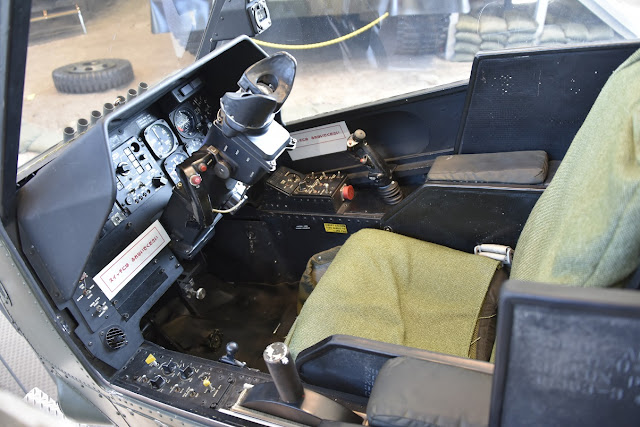 |
| Cockpit of the AH-1S ( front ) |
 |
70mm rocket, 20mm autocannon ammunition, an a scale model
of the AH-64D Apache attack helicopter. |
Type 90 Main Battle Tank
Other Than the AH-1S Cobra, the other major indoor attraction on display is without doubt the
Type 90 Main Battle Tank. Adjacent to and with its 120mm main gun pointing at the AH-1S, the Type 90 tries to steal the thunder from the helicopter. Though still in active deployment, the Type 90 has been superseded by the newer and more advanced Type 10 main battle tank which was displayed at the outdoor area. On special occasions, the commander's seat will be open to the public for a taste of what it is like to be inside a tank. For this reason, the museum had installed fixed railings on the turret to prevent visitors from falling off.
Next to the tank were displays of its ammunition - HEAT and APFSDS rounds for the Rheinmetall 120mm smoothbore gun.
 |
| The Type 90 Main Battle Tank on display at the museum. |
 |
| The Type 90 MBT with stairs linking to level 2 in the background. |
 |
| Type 90 MBT Ammunition : 120mm HEAT ( top ) and APFSDS ( bottom ) |
Gunner's Periscope
Next to the Type-90 MBT is a little arcade-like box structure that simulates the tank gunner's primary targeting sight and allows the visitor to have a feel of how it is like to aim the 120mm gun.
 |
| Gunner's primary sight periscope |
 |
| Gunner's primary sight periscope |
Infantry Weapons and Equipment
Of course the display would not be complete without a show of infantry weapons and equipment. After all, the lowly and unappreciated foot soldier is the mainstay of any ground force. So there is the usual army uniforms, boots, helmets and even gas masks being displayed using mannequins.
The standard infantry rifle, the squad automatic weapon and the tank mounted general purpose machine gun were showcased. Even the Type 91 portable surface to air missile is displayed.
 |
Top to bottom : Howa Type 89 assault rifle 5.56mm,
Sumitomo MINIMI Light machine gun 5.56mm,
Sumitomo Type 74 turret mounted co-axial machine gun 7.62mm. |
 |
Toshiba Type 91 man-portable surface-to-air missile
aka Hand Arrow |
Another section had a backpack, a flak jacket and a parachute pack weighing exactly like what they would when worn or carried by the soldiers. The visitor can experience the actual weight of these loads by putting them on their backs.
 |
| Lead weighted packs and vest to simulate an infantryman's load. |
 |
Aviator's Helmet, Type 88 Steel helmet, aviator's boots,
combat backpack, Type 2 bullet-proof vest. |
 |
| Type 00 chemical warfare protective equipment. |
 |
| Motorcycle for reconnaissance |
Army Rations
As Napoleon Bonaparte had famously said, an army marches on its stomach. It is therefore not surprising to see JGSDF field rations as part of the exhibit. What is unusual here is simply the variety of ration types available to the Japanese self-defense force personnel. It is almost like a mini Japanese kaiseki cuisine. Curry bonito with rice, Miso mackerel, spicy Mabo vegetable, stir fried pork with ginger, beef stew, meatballs ... the list goes on.
 |
| JGSDF combat rations |
3D Theatre
A small audio-visual room screens 3D movies on the history and equipment of the JGSDF. Be warned that they are all in Japanese language only, since the center does not expect non-Japanese visitors usually. The audience will also have to don 3D glasses when viewing the movies.
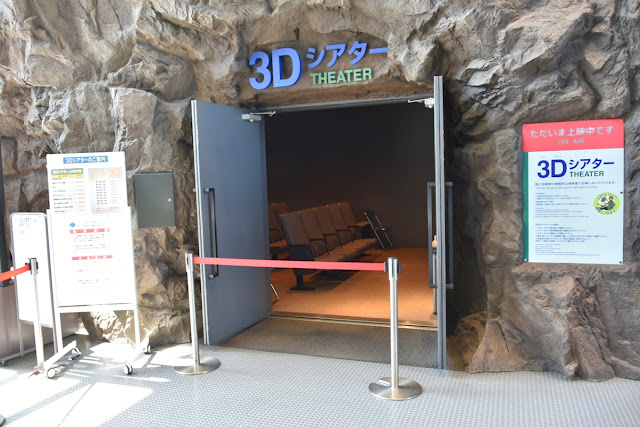 |
| 3D theater |
Helicopter Simulator
A small flight simulator occupies an area next to the AH-1S. In it two persons can sit side by side to experience the simulated flight of an attack helicopter. Flight control is however not available and the visitor and only feel the pitching and yawing of the cockpit with a lot of background noise of the rotors.
Rent A Uniform
Among the unusual features of the museum is its military uniform rental service which is free of charge. Visitors can go to the rental corner which has racks of army fatigues of various sizes neatly displayed and ask for a suitable uniform to wear within the museum. They can then stroll around the center and pose for photographs next to the military hardware on display. So don a uniform, look smart and pretend to be a soldier today. Hopefully in time to come you'll be part of the SDF.
Outdoor Display
Apart from the indoor exhibits, there are more armoured vehicles and helicopters to be seen at the outdoor static display just behind the main museum building. As the visitor exits the main hall, the first thing that comes to sight is an underground command bunker. You literally have to descend a flight of stairs to view this command center which is rather claustrophobic.
 |
| Entrance to the underground command post |
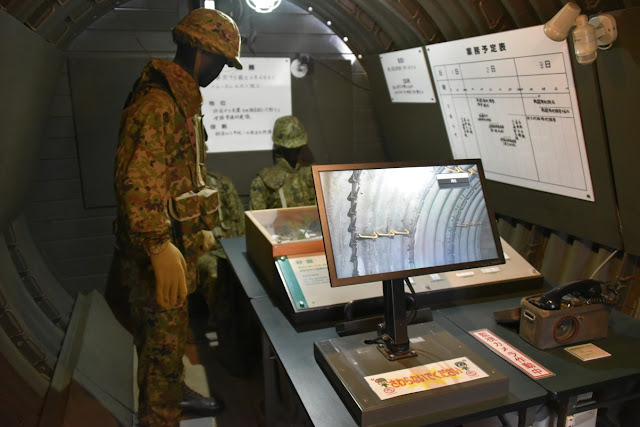 |
| Inside the command bunker |
It is much better to be out in the open with the sunshine warming your face and two neat rows of air and land vehicles waiting for you to inspect.
 |
Outdoor display R to L : Type 10 MBT, Type 74 MBT,
Type 96 Wheeled APC, Type 89 IFV, Type 87 SPAAG,
Type 94 Beach Minelayer. |
 |
Outdoor static display L to R : UH-1, Type 75 155mm SPH,
Type 74 105mm SPH, Medium ranged multi-purpose missile carrier. |
 |
| The Type 10 MBT - probably the most popular among the outdoor displays. |
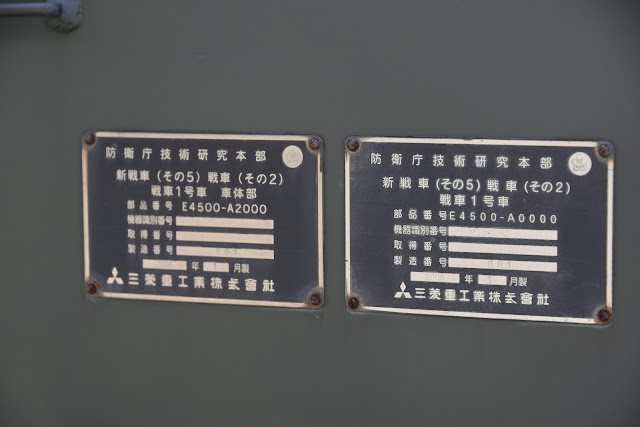 |
The Type 10 BMT on display is the original prototype which
the Technical Research And Development Institute
( now Acquisition, Technology And Logistics Agency ) commissioned
Mitsubishi Heavy Industries to build in 2008,
as indicated by these plates on the chassis. |
 |
Type 74 MBT with 105mm rifled gun.
Still listed on the JGSDF website but completely obsolete.
Meant to be replaced by the Type 90 BMT. |
 |
| Type 89 Infantry Fighting Vehicle. |
 |
| Komatsu Type 96 Wheeled Armoured Personnel Carrier. |
 |
Type 87 Self-Propelled Anti-Aircraft Gun
with twin 35mm Oerlikon autocannons. |
 |
| Type 94 Beach Mine Layer |
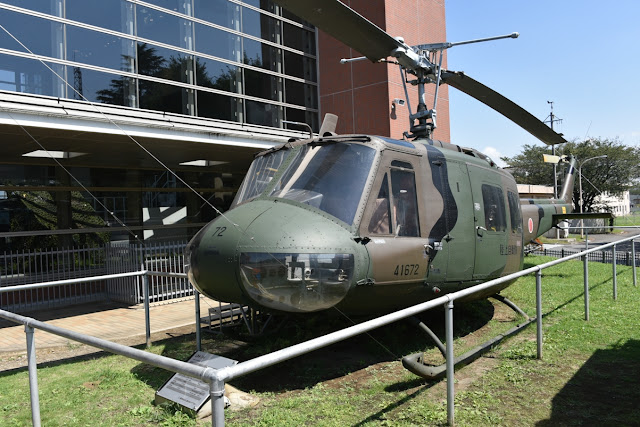 |
| Fuji UH-1H |
 |
| Type 75 155mm Self-Propelled Howitzer |
 |
| Type 74 105mm Self-Propelled Howitzer |
 |
| Missile carrier : Medium Ranged Multi-purpose Guided Missile |
 |
Fuji Heavy Industries Flying Forward Observation System
remotely controlled helicopter. |
A Museum That Is Not A Museum
Just like its parent organization which is obviously a military body but is known as a self defense force, the JGSDF Public Information Center has all the characteristics and hallmark of a museum but it is not called a museum. The International Council of Museum ( ICOM ) defines a museum as " a non-profit, permanent institution in the service of society and its development, open to the public, which acquires, conserves, researches, communicates and exhibits the tangible and intangible heritage of humanity and its environment for the purposes of education, study and enjoyment ". For all intent and purposes, the JGSDF Public Information Center fits all those descriptions, and most rational minds would have classified it as a museum.
How To Make The JGSDF Public Information Center Better
From my very brief visit to Rikkunland on a typical weekday morning, I could tell that it has excellent content that could attract a niche group of visitors, namely local Japanese military enthusiasts. I thoroughly enjoyed the visit and I felt that it was well worth the half day trip from Tokyo. However, I noticed there were few visitors to the center that day. Hopefully the center would draw a larger crowd on weekends. In order to better fulfill its original role of recruiting young Japanese men and women to join the ranks of the JGSDF, the center could have done more.
A Better Name
A much shorter and catchy name might be useful, like Rikugunkan ( 陸軍館 ) which means Army Museum. Anything but Japan Ground Self-Defense Force Public Information Center. It will be easier to remember and also to search for.
A Better Location
The current location of the center adjacent to Camp Asaka makes it convenient for the GSDF personnel to rotate large and heavy military hardware on exhibition but is not easily accessible by the visiting public. Wako City is 20 minutes by rail from Ikebukuro and the camp and center is another 20 minutes away on foot. It would be better if the center is located within metropolitan Tokyo itself, somewhere where lots of young people frequent. That way visitor traffic would be higher. The center currently has an average of about 100000 visitors per year. That's way lower than the figures for the Yamato Museum in Kure which received about 1 million visitors per year.
Contemporary Hardware
Though the center did have on display some modern latest generation hardware like the Type 10 main battle tank, a lot of the exhibits were legacy systems that are either phased out or on the way out. For example, instead of the AH-1S cobra helicopter gunship as the centerpiece, why not have the latest AH-64D displayed? If the JGSDF cannot spare an extra airframe for display, a 1:1 scale replica would do as well.
Also, there are some weapon systems in the GSDF's inventory that are obviously missing, like the M-270 multiple launch rocket system and the M-110 203mm self-propelled howitzer. I was just about to include the Patriot surface to air missile until a quick check revealed that they are JASDF inventory.
Interactive Displays
Japan is a country well known for its technological innovations. In fact the Japanese love to use advanced technology to offer solutions to the many problems that plague their society. The use of robotics to overcome the shortage of labour due to an ageing population is a good example. In the same way, the center should harness technology to make its exhibits more interactive and for the visitor to have a more immersive experience. The 3D theatre is passé. All the major TV manufacturers have abandoned 3D in their latest offerings. We are now into augmented reality and virtual reality. Why not have a VR combat simulator that allows for an out of this world experience of the future battlefield?
Well Designed Mascot
I have to be honest, Rikkun and Asaka Chan, the current male and female mascot of the center are not the cutest nor the most lovable creatures ever designed. They looked like eggs with arms and legs and reminded me of Humpty Dumpty first and foremost. Maybe I am missing something that only the Japanese can understand but having something that look less fragile and less obese perhaps may be a better brand ambassador for the JGSDF. A well designed mascot will project a very different image of the ground forces especially now that Prime Minister Abe is trying to change the Post-War Peace Constitution.
The Killer App
Finally, if the museum were to attract young visitors, having a star attraction that appeals to people of that generation would certainly be useful. Japan being a land of manga ( comics ) and anime ( cartoons ), choosing a strong character from one of the popular series and turning it into a highly visible iconic landmark for the museum might just do the trick.
Which character to choose? I think JGSDF already has the perfect candidate and it is none other than the world's most famous lizard Godzilla. For decades, in almost every Godzilla movie, the reptile has been making a fool of the Japanese Self Defense Forces, chomping up fighter aircrafts and helicopters in the sky and crushing tanks, armoured vehicles and soldiers on the ground. It seems the SDF could never win. The time has come to make the lizard work for the SDF, for once.
If the JGSDF could create a huge Godzilla replica that towers way above the museum building and make it look as if it is attacking the building itself, that could become the museum's main crowd puller and a recognizable local landmark. The rooftop area can also be made accessible to visitors to be standing next to the replica for photograph taking.
And to make it even more interesting, a life-sized diorama can be set up by rearranging the currently neatly parked array of artillery pieces, tanks and infantry fighting vehicles on static display at the court yard behind the museum building to make them look as if they are fighting the monster lizard.
Anything would be better than the current drape office building lookalike appearance of the museum.
A Museum Worth Visiting?
Even in its current form, the JGSDF Public Information Center is an interesting place to visit for military buffs, definitely worth spending half a day if you find yourself in Tokyo with time to kill. With the exception of license-built hardware like the AH-1S or UH-1, almost all the displayed armoured vehicles and tube artillery are unique to the Japanese SDF as none have ever been exported to other countries.
Applying a more modern operating concept might make the museum more attractive and relevant to the younger generation, its main target population. With its future I certainly hope JGSDF will continue to improve on its already excellent museum and take it to the next level.































































